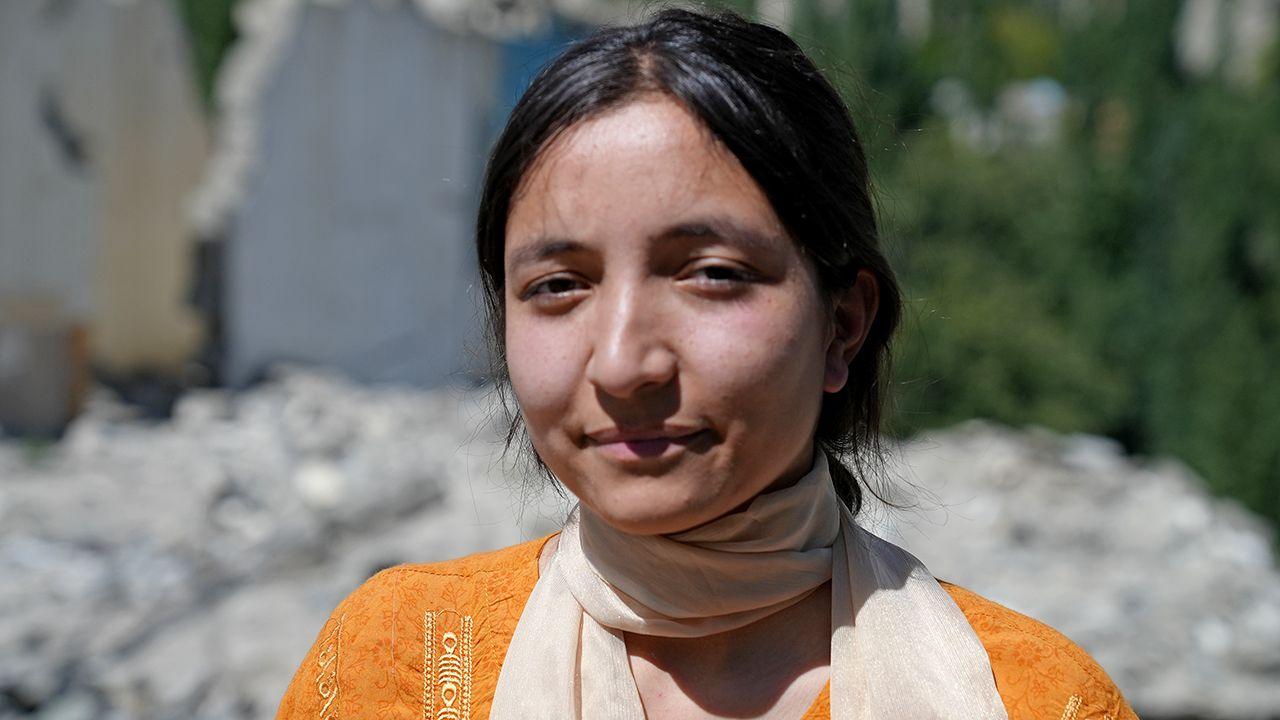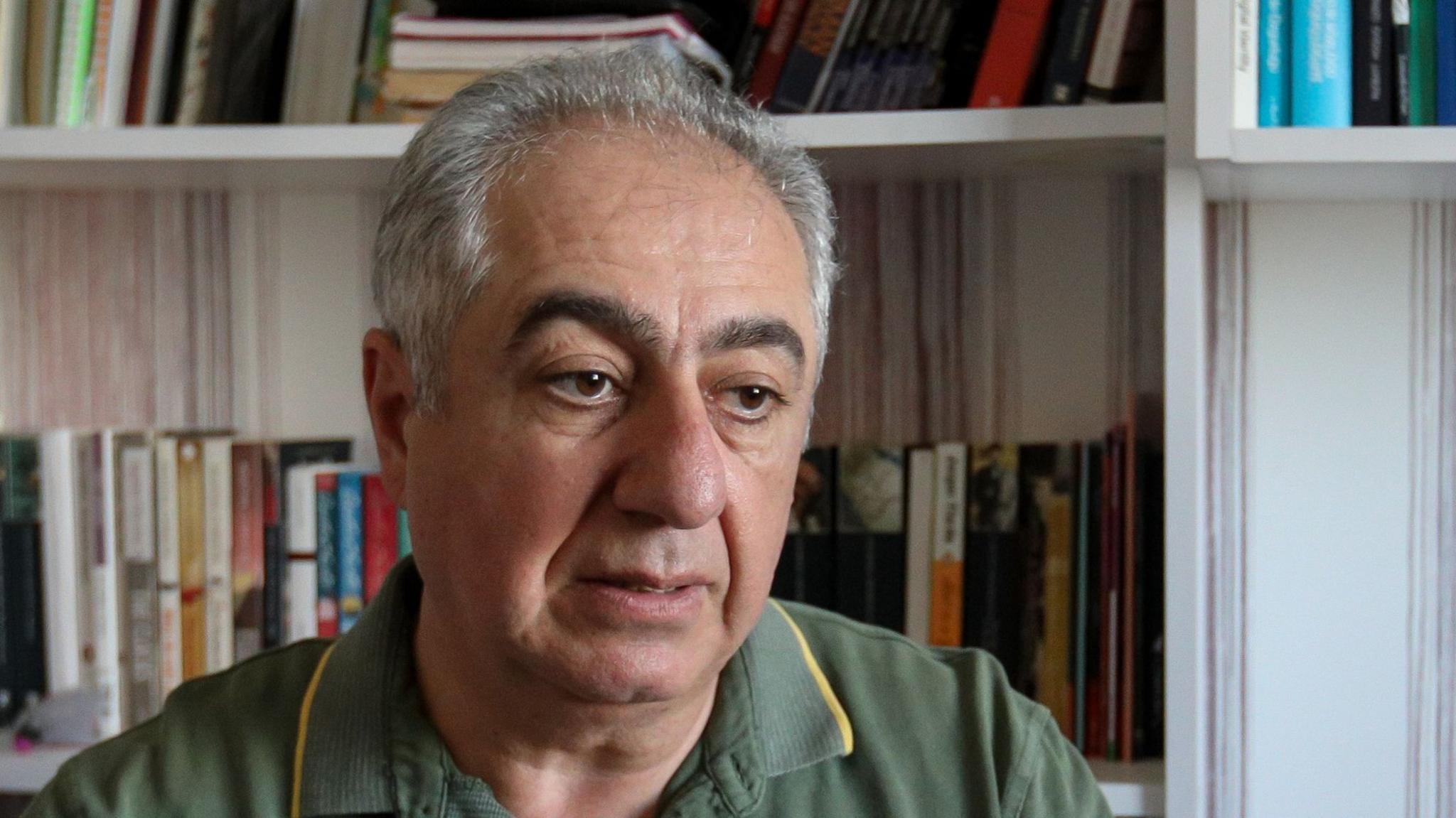Melting glaciers leave homes teetering in valley of jagged mountains
- Published

Komal’s morning view was of jagged, forbidding mountains, the rush of the river dozens of metres below the family home on the cliff. That was until the water became a torrent and tore the ground away beneath their feet.
“It was a sunny day,” says Komal, 18.
For generations, her family had lived among the orchards and green lands in the heart of the Hunza valley in the Karakorum mountains of Pakistan-administered Gilgit-Baltistan region.
“In the morning everything was normal, I went to school,” Komal says, “but then my teacher told me that Hassanabad bridge had collapsed.”
Upstream, a glacial lake had formed, then suddenly burst - sending water, boulders and debris cascading down the valley and gathering speed. The ground trembled so violently some people thought there was an earthquake.
When the torrent hit the cement bridge that connected the two parts of the village, it turned it to rubble.

A house in the damaged village of Hassanabad, with walls missing after the ground gave way
“By the time I came home, people were taking what they could out of their home,” Komal says. She grabbed books, laundry, anything she could carry, but remembers thinking that with their house so far above the water there was no way it could be affected.
That was until they received a phone call from the other side of the valley; their neighbours could see that the water was stripping away the hillside their home stood on.
Then the homes began to collapse.
“I remember my aunt and uncle were still inside their home when the flood came and washed out the whole kitchen,” she says. The family made it to safe ground, but their homes disappeared over the edge.
Drone footage shows changing landscape of Karakorum glaciers
Today, walking through the grey rubble and dust, there are still coat hooks on the wall, a few tiles in the bathroom, a window with the glass long gone. It’s been two years, but nothing has grown on the crumbling cliff that used to be Komal's garden in Hassanabad.
“This used to be all a green place,” she says. “When I visit this place I remember my childhood memories, the time I spent here. But the barren places, they hurt me, they make me feel sad.”

Life in the region is precarious. Water from the Hopper glacier can be seen here running through the valley it has carved
Climate change is altering the landscape across Gilgit-Baltistan and neighbouring Chitral, researchers say. This is just part of an area referred to by some as the Third Pole; a place which has more ice than any other part of the world outside the polar regions.
If current emissions continue, Himalayan glaciers could lose up to two-thirds of their volume by the end of this century, according to the International Centre for Integrated Mountain Development, external.
According to the Aga Khan Development Network (AKDN), more than 48,000 people across Gilgit Baltistan and Chitral are considered to be at high risk from a lake outburst or landslide. Some, like the village of Badswat in the neighbouring district of Ghizer, are in such peril they are being evacuated entirely to relative safety, their homes rendered impossible to live in.
“Climate change has increased the intensity and frequency of disasters across the region,” says Deedar Karim, programme co-ordinator for the Aga Khan Agency for Habitat.
“These areas are highly exposed. With the increase in temperature, there are more discharges (of water) and then more flooding. It’s causing damage to infrastructure, houses, agricultural lands; every infrastructure has been damaged by these increasing floods.
“The rainfall pattern is changing. The snowfall pattern is changing and then the melting of the glacier is changing. So it’s changing the dynamics of hazards.”

Pakistan is among the world’s most at-risk countries from glacial lake outbursts
Moving populations is complicated; not only have many spent centuries on their land and are loath to leave it, but finding another location that is safe and has access to reliable water is complicated.
“We have very limited land and limited resources. We don’t have common lands to shift people to,” says Zubair Ahmed, assistant director of the Disaster Management Authority in Hunza and Nagar district.
“I can say that after five or 10 years, it will be very difficult for us to even survive. Maybe people will realise after a few years or decades, but by then it will be too late. So I think this is the right time, although we are still late, but even now this is the time to think about it.”
Pakistan is one of the countries most vulnerable to climate change, although it is only responsible for less than 1% of global greenhouse gas emissions, external.
“We cannot stop these events, because this is a global issue,” Mr Ahmed says. “All we can do is mitigate and get our people prepared to face such events.”

Ijaz is an emergency volunteer, trained in evacuations, first aid and mountain rescue
In the village of Passu, just over an hour’s drive from Hassanabad, they are holding an evacuation drill; preparation for potential destruction. The population know that if there is an emergency, it may take days for outside help to arrive if the roads and bridges are blocked, damaged or swept away.
Trained in first aid, river crossing and high mountain rescue, they practise evacuating the village a few times a year, volunteers carrying the wounded on stretchers and bandaging mock injuries.
Ijaz has been a volunteer for the last 20 years, with many stories of rescuing lost walkers in the mountains. But he too is worried about the number of dangers and the increased unpredictability of the weather in the area he calls home.
“The weather now, we just can’t say what will happen,” he says. “Even five years ago, the weather didn’t change as much. Now after half an hour we can’t say what it will be.”
He knows too, that there’s only so much his team of volunteers can do.
“Unfortunately, if the flood comes and it’s a heavy flood we can’t do anything,” he says. “The area is totally washed out. If it’s small then we can help people survive and escape the flood areas.”

If there is an emergency it may take days for outside help to arrive
There are other mitigation measures across the region; stone and wire barriers to try to slow floodwater, systems to monitor glacier melt, rainfall and water levels, speakers installed in villages to warn the community if danger looks likely. But many who work here say they need more resources.
“We have installed early warning systems in some valleys,” says Mr Ahmed. “These were identified by the Pakistan Meteorological Department and they gave us a list of around 100 valleys. But because of limited resources, we are only able to intervene in 16.”
He says they are in discussions to expand this further.

Sultan Ali says he feels helpless - if the flood comes, it will take everything away
A few houses along from Komal lives Sultan Ali, now in his 70s.
As we talk sitting on a traditional charpoy bed, his granddaughters bring us a plate of pears they’ve picked from their garden.
He knows that should another flood happen, his home could also disappear into the valley, but says he has nowhere to go.
“As I approach the end of my life, I feel helpless,” he tells me. “The children are very worried, they ask where will we live?
“We have no options. If the flood comes, it will take everything away and there’s nothing we can do about it. I can’t blame anyone; it’s just our fate.”

Komal doesn't think they'll be able to stay - but they have nowhere else to go
We watch his grandchildren play tag in the shade of the orchard. The seasons, the ice, the environment is changing around them. What will this land look like when they are older?
Komal too is not sure what the future will hold.
“I don’t think we will stay here forever,” she says. “The condition is clear already. But the question for us is we have no other place to go. Only this.”
Additional reporting and images by Kamil Khan
- Published17 November 2024

- Published15 November 2024
